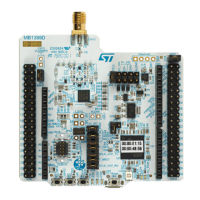Embedded Flash memory (FLASH) RM0453
116/1461 RM0453 Rev 1
On system reset rising, internal option registers are copied into the following option registers
that can be read and written by software:
• FLASH_OPTR
• FLASH_PCROP1xSR (x=A or B)
• FLASH_PCROP1xER (x=A or B)
• FLASH_WRP1xR (x=A or B)
• FLASH_IPCCDBA
• FLASH_SFR
• FLASH_SRRVR
These registers are also used to modify the options. If these registers are not modified by
the user, they reflect the options states of the system. See Modify user options for more
details.
4.4.3 Sub-GHz radio SPI security
When the system is secure (ESE = 1), the access to the sub-GHz radio SPI interface for the
radio system can be made secure by the user option SUBGHSPISD. When secure, only the
secure CPU2 has access to the sub-GHz radio SPI.
Access can be further restricted to secure privileged access only by the PRIV2 bit for sub-
GHz radio SPI in GTZC TZSC privileged configuration register
(GTZC_TZSC_PRIVCFGR1).
4.5 Secure system memory
4.5.1 Introduction
The secure system memory stores RSS (root secure services) firmware that is programmed
by ST during STM32WL5x production. The RSS provides secure services to the bootloader
and the user firmware.
4.5.2 RSSLIB functions
The RSS provides runtime services thanks to the RSS library. As other microcontroller
peripheral features and mapping, the RSS library functions are exposed to user within the
CMSIS device header file provided by the STM32CubeWL firmware package. Refer to the
user manual Getting started with STM32CubeWL for STM32WL Series (UM2643) for more
details.
RSS library functions (named RSSLIB functions hereafter) are described in the CMSIS and
can only be called by Cortex-M0+ firmware.
These functions are located at the address RSSLIB_PFUNC. RSSLIBPFUNC is used to call
the function (see example below).
CloseExitHDP
Prototype:
uint32_t CloseExitHDP(uint32_t HdpArea, uint32_t VectorTableAddr)

